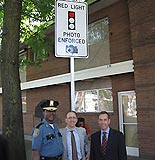Article from: www.thenewspaper.com/news/23/2379.asp
5/19/2008
Seattle, Washington Shortens Yellow Lights
Seattle, Washington shortens yellow lights as it expands its red light camera program.
 A city traffic engineer admitted reducing the length of yellow lights at downtown Seattle, Washington intersections by half-a-second. Seattle Traffic Management Director Wayne Wentz told the Seattle Post-Intelligencer newspaper that the reduction was not designed to increase the profit of the city's expanding red light camera program. Instead, the changes made at more than 200 intersections in March were designed to increase traffic flow.
A city traffic engineer admitted reducing the length of yellow lights at downtown Seattle, Washington intersections by half-a-second. Seattle Traffic Management Director Wayne Wentz told the Seattle Post-Intelligencer newspaper that the reduction was not designed to increase the profit of the city's expanding red light camera program. Instead, the changes made at more than 200 intersections in March were designed to increase traffic flow.
"Many of our downtown signals were operating with four seconds of yellow time, then going directly to green for the other direction," Wentz said. "During our recent optimization, we changed the signals to 3.5 seconds of yellow time."
Wentz dismissed the effect of the change by explaining that a different factor, the all-red period at the intersection, was extended as the yellow had been shortened. A 2005 study by the Texas Transportation Institute tested the effect of both reducing and extending the length of yellow lights at intersections. A one-second reduction generated a 110 percent increase in violations, whereas increasing the length of the yellow beyond the minimum amount reduced both violations and accidents (view study). Each extra violation allows Seattle to issue another $124 ticket.
Seattle issued $1.4 million worth of these tickets in a ten-month period from the program's start in June 2006 to May 2007. The city's own progress report showed that during this period the program failed to reduce accidents at the original four intersections (view report). At the beginning of 2008, the city announced it was expanding the program to cover 22 intersections.
Seattle is likely to be one a handful of documented cases of cities shortening yellow light duration after the installation of red light cameras. It is far more common for cities to follow national signal timing guidelines that have changed over a period of more than a decade to give a decreasing amount of warning to motorists of impending red lights (view US House report). As a result, cities and private vendors choose to install cameras at locations where the yellow had been shortened many years before cameras were installed (see San Diego memo).
 A city traffic engineer admitted reducing the length of yellow lights at downtown Seattle, Washington intersections by half-a-second. Seattle Traffic Management Director Wayne Wentz told the Seattle Post-Intelligencer newspaper that the reduction was not designed to increase the profit of the city's expanding red light camera program. Instead, the changes made at more than 200 intersections in March were designed to increase traffic flow.
A city traffic engineer admitted reducing the length of yellow lights at downtown Seattle, Washington intersections by half-a-second. Seattle Traffic Management Director Wayne Wentz told the Seattle Post-Intelligencer newspaper that the reduction was not designed to increase the profit of the city's expanding red light camera program. Instead, the changes made at more than 200 intersections in March were designed to increase traffic flow.